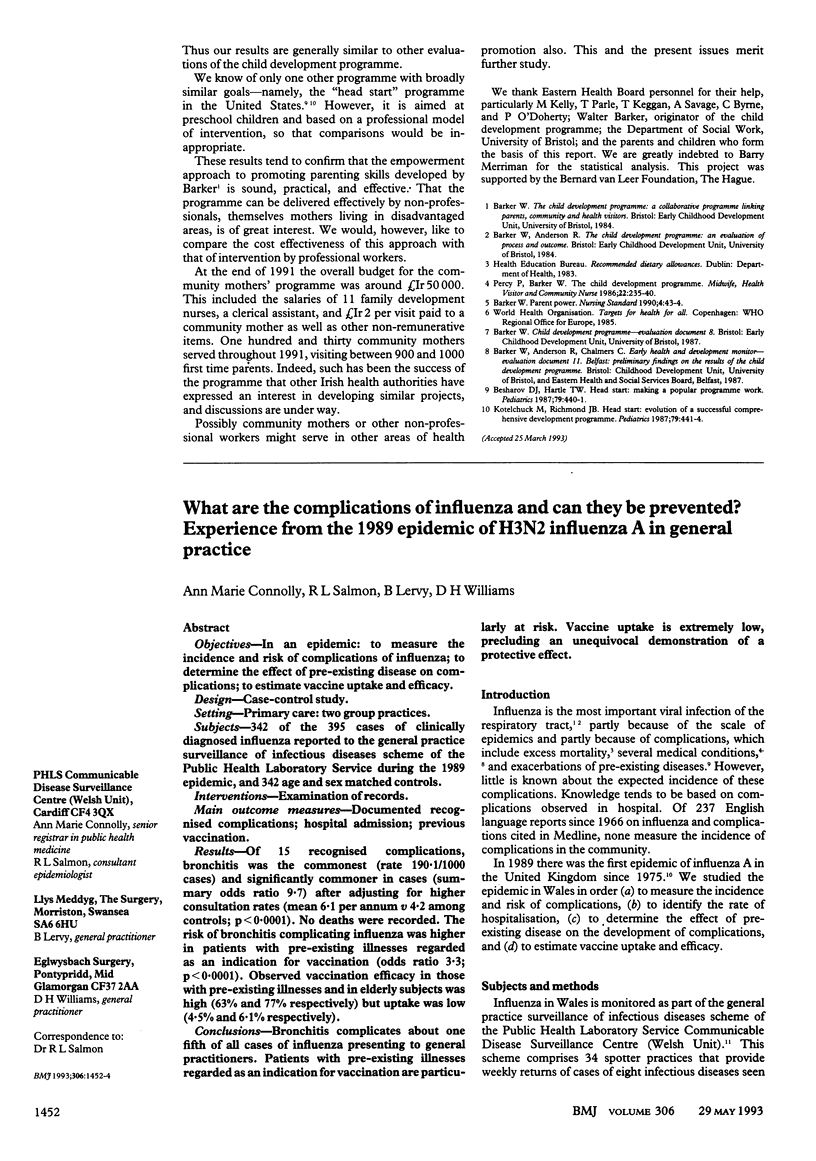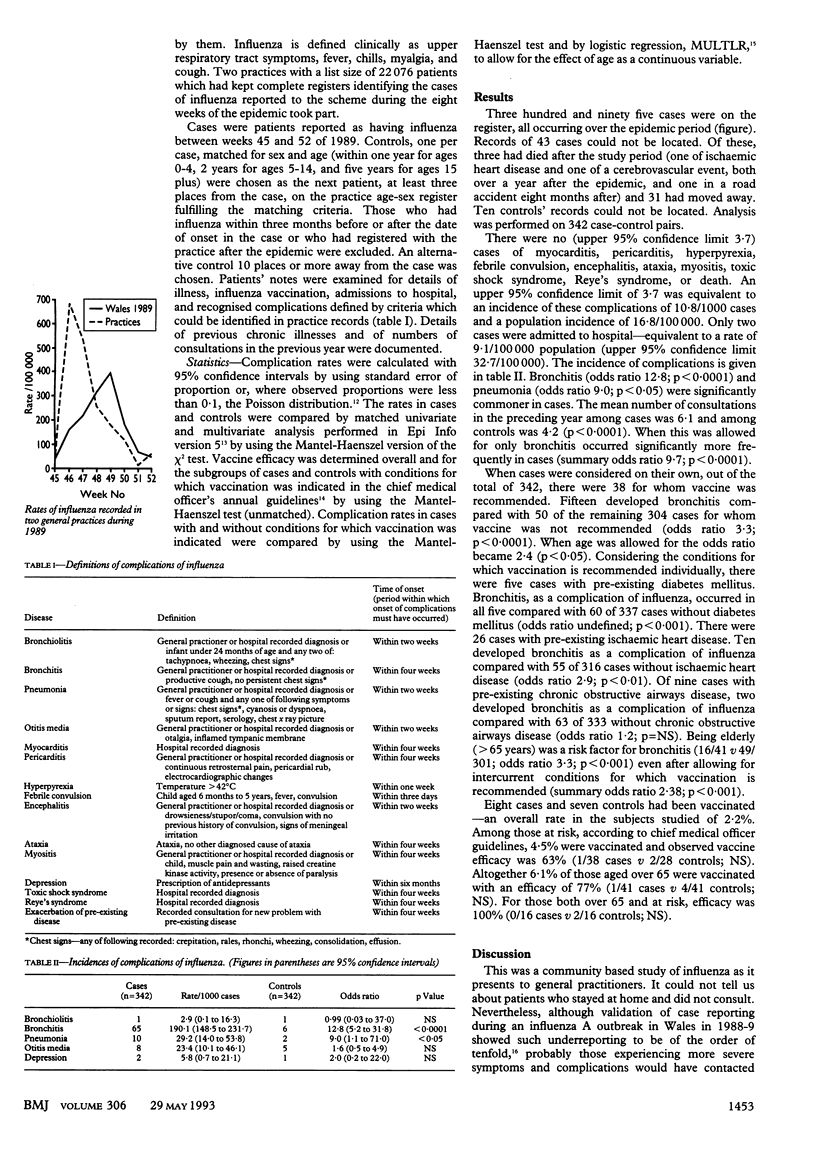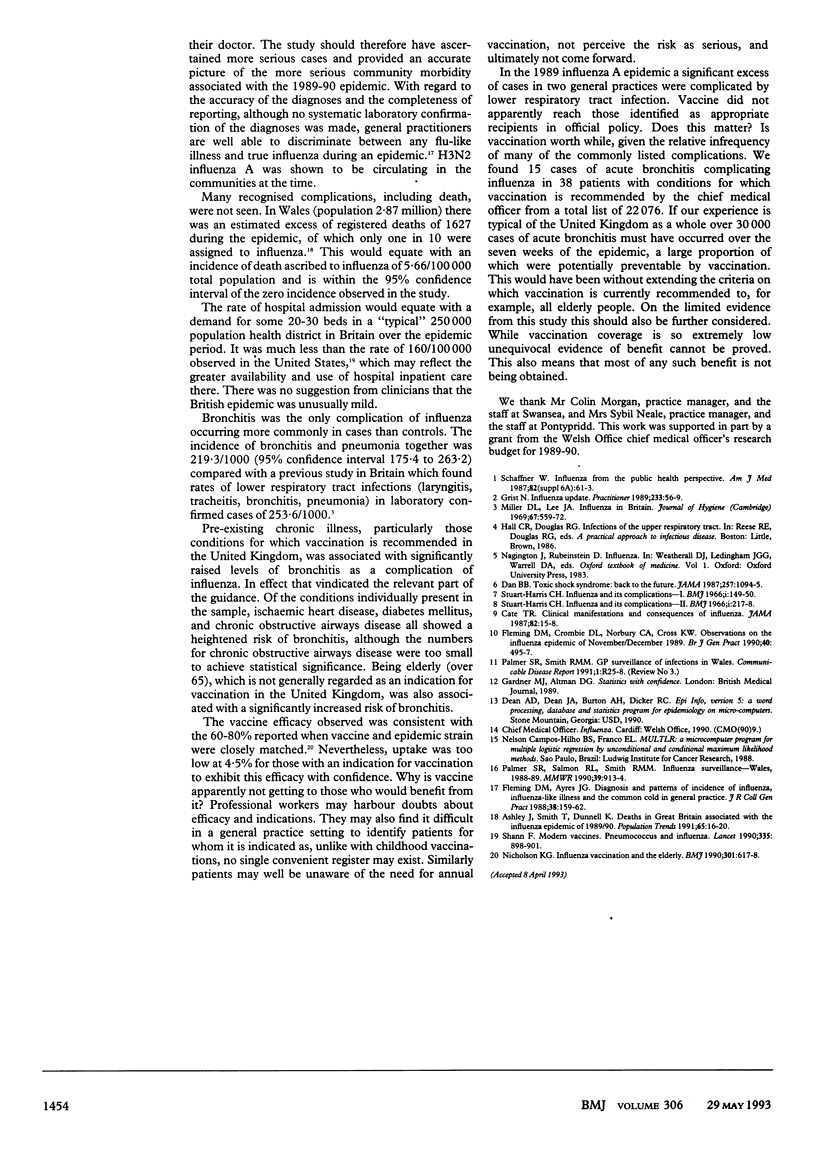Abstract
OBJECTIVES--In an epidemic: to measure the incidence and risk of complications of influenza; to determine the effect of pre-existing disease on complications; to estimate vaccine uptake and efficacy. DESIGN--Case-control study. SETTING--Primary care: two group practices. SUBJECTS--342 of the 395 cases of clinically diagnosed influenza reported to the general practice surveillance of infectious diseases scheme of the Public Health Laboratory Service during the 1989 epidemic, and 342 age and sex matched controls. INTERVENTIONS--Examination of records. MAIN OUTCOME MEASURES--Documented recognised complications; hospital admission; previous vaccination. RESULTS--Of 15 recognised complications, bronchitis was the commonest (rate 190.1/1000 cases) and significantly commoner in cases (summary odds ratio 9.7) after adjusting for higher consultation rates (mean 6.1 per annum v 4.2 among controls; p < 0.0001). No deaths were recorded. The risk of bronchitis complicating influenza was higher in patients with pre-existing illnesses regarded as an indication for vaccination (odds ratio 3.3; p < 0.0001). Observed vaccination efficacy in those with pre-existing illnesses and in elderly subjects was high (63% and 77% respectively) but uptake was low (4.5% and 6.1% respectively). CONCLUSIONS--Bronchitis complicates about one fifth of all cases of influenza presenting to general practitioners. Patients with pre-existing illnesses regarded as an indication for vaccination are particularly at risk. Vaccine uptake is extremely low, precluding an unequivocal demonstration of a protective effect.
Full text
PDF


Selected References
These references are in PubMed. This may not be the complete list of references from this article.
- Centers for Disease Control (CDC) Influenza surveillance--Wales, 1988-89. MMWR Morb Mortal Wkly Rep. 1990 Dec 21;39(50):913–914. [PubMed] [Google Scholar]
- Dan B. B. Toxic shock syndrome: back to the future. JAMA. 1987 Feb 27;257(8):1094–1095. [PubMed] [Google Scholar]
- Fleming D. M., Ayres J. G. Diagnosis and patterns of incidence of influenza, influenza-like illness and the common cold in general practice. J R Coll Gen Pract. 1988 Apr;38(309):159–162. [PMC free article] [PubMed] [Google Scholar]
- Fleming D. M., Crombie D. L., Norbury C. A., Cross K. W. Observations on the influenza epidemic of November/December 1989. Br J Gen Pract. 1990 Dec;40(341):495–497. [PMC free article] [PubMed] [Google Scholar]
- Grist N. Influenza update. Practitioner. 1989 Jan;233(1461):56-8, 60. [PubMed] [Google Scholar]
- McKenna M. J., Frame B. Hormonal influences on osteoporosis. Am J Med. 1987 Jan 26;82(1B):61–67. doi: 10.1016/0002-9343(87)90273-7. [DOI] [PubMed] [Google Scholar]
- Miller D. L., Lee J. A. Influenza in Britain 1967-68. J Hyg (Lond) 1969 Sep;67(3):559–572. doi: 10.1017/s0022172400042005. [DOI] [PMC free article] [PubMed] [Google Scholar]
- Nicholson K. G. Influenza vaccination and the elderly. BMJ. 1990 Sep 29;301(6753):617–618. doi: 10.1136/bmj.301.6753.617. [DOI] [PMC free article] [PubMed] [Google Scholar]
- Shann F. Modern vaccines. Pneumococcus and influenza. Lancet. 1990 Apr 14;335(8694):898–901. doi: 10.1016/0140-6736(90)90489-r. [DOI] [PubMed] [Google Scholar]
- Stuart-Harris C. H. Influenza and its complications. I. Br Med J. 1966 Jan 15;1(5480):149–150. doi: 10.1136/bmj.1.5480.149. [DOI] [PMC free article] [PubMed] [Google Scholar]
- Stuart-Harris C. H. Influenza and its complications. II. Br Med J. 1966 Jan 22;1(5481):217–218. doi: 10.1136/bmj.1.5481.217. [DOI] [PMC free article] [PubMed] [Google Scholar]


